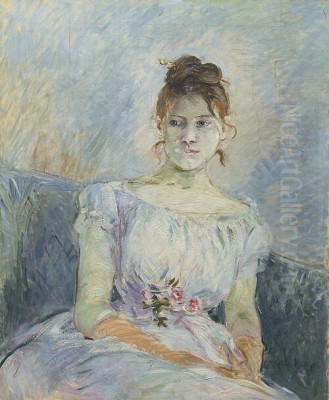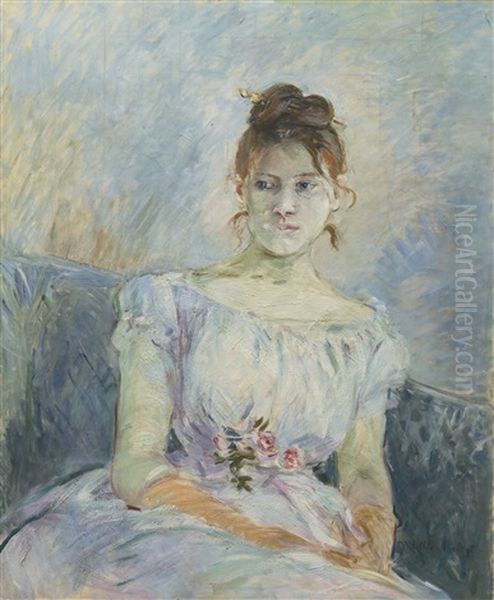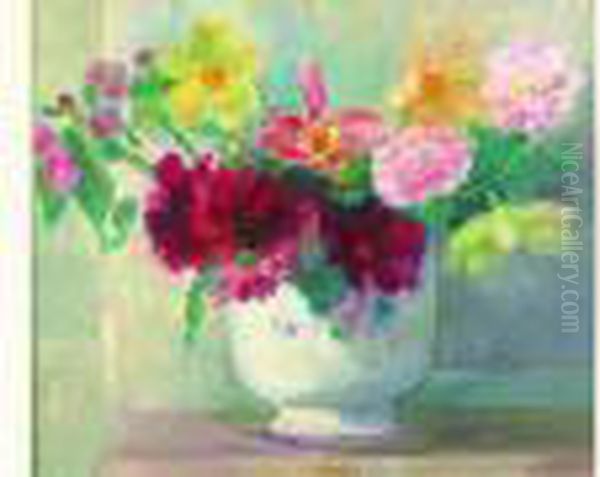
Paule Gobillard stands as a fascinating figure in the landscape of late 19th and early 20th-century French art. Born in Quimperlé, France, on December 3, 1867, and passing away in Paris on February 27, 1946, her life and career were intrinsically linked to the Impressionist movement, primarily through her close familial ties to one of its leading female figures, Berthe Morisot. While perhaps less universally recognized than her famous aunt, Gobillard carved out her own distinct artistic path, creating a body of work characterized by sensitivity, intimacy, and a dedication to the Impressionist aesthetic.
As a French national, Gobillard's identity was deeply rooted in the cultural and artistic milieu of her time. Her lifespan bridged the height of Impressionism, the rise of Post-Impressionism, Fauvism, Cubism, and the myriad other artistic currents that swept through Paris. Yet, her own work remained largely faithful to the principles she absorbed in her youth, focusing on light, color, and the fleeting moments of everyday life.
Early Life and Artistic Formation
Paule Gobillard's entry into the world of art was almost preordained. She was the daughter of Théodore Gobillard and Yves Morisot, the latter being the sister of the renowned painter Berthe Morisot. This connection placed Paule and her younger sister, Jeannie (born 1877), directly into the heart of the Impressionist circle from a very young age. The family environment was one steeped in artistic discussion, creation, and association with the leading avant-garde figures of the day.
Tragedy struck early in Paule's life. Following the death of their mother, Yves, in 1893, Paule and Jeannie became orphans (their father having passed away earlier). Berthe Morisot, along with her husband Eugène Manet (brother of the famous painter Édouard Manet), took the young women under their wing. They moved into the Morisot-Manet household in Paris, a hub of artistic activity and intellectual exchange. This move proved pivotal for Paule's artistic development.

Living with Berthe Morisot provided Paule with unparalleled access to artistic guidance. Morisot, a founding member of the Impressionist group, actively mentored her niece. Paule frequently served as a model for Morisot, appearing in several significant paintings, including the striking Paule Gobillard en robe de bal (Paule Gobillard in a Ball Gown) from 1887. This experience not only familiarized her with the process of painting but also immersed her in the visual language of Impressionism.
Beyond Morisot's direct tutelage, Paule benefited from the wider artistic circle. She received encouragement and likely informal instruction from other giants of the era who frequented her aunt's home. Notable among these were Pierre-Auguste Renoir, known for his luminous depictions of figures and landscapes, and the master draftsman Edgar Degas. Both artists, along with Morisot, guided her exploration of oil painting, watercolor, and pastel techniques, shaping her understanding of form, light, and composition.
Developing an Artistic Voice
Paule Gobillard absorbed the lessons of her mentors but gradually developed her own artistic personality. She embraced the core tenets of Impressionism: the emphasis on capturing the effects of light and atmosphere, the use of broken brushwork and a vibrant palette, and a focus on modern life subjects. However, her work often possesses a particular intimacy and quietude, reflecting her personal experiences and perspective.
Her formal debut as an exhibiting artist occurred in 1894, when she presented her work at the prestigious Salon des Indépendants in Paris. This marked the beginning of a consistent, albeit relatively understated, exhibition career. She would continue to show her work regularly at the Indépendants and later at the Salon d'Automne (including the 1904 exhibition) and the Salon des Tuileries (participating, for instance, in 1926).
Gobillard's preferred subjects were drawn from her immediate surroundings and personal life. She excelled at depicting intimate domestic scenes, often featuring women and children engaged in quiet activities like reading, sewing, or playing. Gardens and landscapes, rendered with a sensitivity to changing light, also feature prominently in her oeuvre. Still lifes provided another avenue for exploring form and color. Her style, while rooted in Impressionism, showed a versatility and a gentle, observant eye.
She worked proficiently in oils, watercolors, and pastels, adapting her technique to the subject and desired effect. Her oil paintings often display the characteristic broken brushwork of Impressionism, while her pastels and watercolors showcase a delicate handling of color and light, capturing ephemeral moments with grace. Throughout her career, she produced a substantial body of work, estimated at over 100 pieces, consistently exploring themes of domesticity, femininity, and the beauty of the everyday.
Family Ties and Artistic Circle

The importance of family in Paule Gobillard's life and art cannot be overstated. After Berthe Morisot's untimely death in 1895, Paule and her sister Jeannie remained close to their cousin, Julie Manet, Morisot's daughter. Julie, an artist herself and a chronicler of the era through her diary, became a central figure in their lives. Paule played a significant role in supporting Julie after her mother's passing.
The close-knit family circle expanded further through marriage. In 1900, a significant double wedding took place: Jeannie Gobillard married the Symbolist poet and essayist Paul Valéry, while Julie Manet married the painter Ernest Rouart (son of the collector Henri Rouart, a friend and patron of Degas). Paule remained deeply connected to both couples, often spending time with them and depicting them and their children in her art. Her relationship with her sister Jeannie and brother-in-law Paul Valéry was particularly close.
This extended family network ensured Paule remained embedded within a vibrant artistic and intellectual community. Figures like Edgar Degas were not just artistic influences but also family friends, famously capturing the Manet, Gobillard, and Valéry families in his late photographic experiments. The poet Stéphane Mallarmé was another close associate of the Morisot circle. Through these connections, Paule would have been aware of, and likely interacted with, many other prominent artists, including potentially Claude Monet, Camille Pissarro, Alfred Sisley, and perhaps even Paul Cézanne, although documentation of direct artistic collaboration or competition is scarce.
Her relationships within this circle appear to have been primarily supportive. Unlike the sometimes-documented rivalries among male artists of the period, Paule Gobillard seems to have found encouragement and subject matter within her familial and social sphere. Her art often celebrates the bonds of family and friendship, reflecting the nurturing environment fostered by Morisot and continued by the next generation. This network provided stability and a continuous connection to the art world throughout her life.
Key Works and Themes
While a comprehensive catalogue raisonné might be lacking compared to more famous contemporaries, several works help illuminate Paule Gobillard's artistic contributions and recurring themes.
As mentioned earlier, Paule often appeared in the works of Berthe Morisot. Paule Gobillard en robe de bal (1887) is a prime example, showcasing Morisot's fluid brushwork and ability to capture the elegance and perhaps slight vulnerability of her young niece. While painted by Morisot, this work is significant in understanding Paule's early immersion in the Impressionist world, serving as both subject and student.

Among Paule Gobillard's own creations, works depicting her family are particularly noteworthy. Madame Paule Valéry et son fils Claude (circa 1910) is a tender portrayal of her sister Jeannie with her nephew. Such paintings underscore Gobillard's focus on intimate family life, rendered with the characteristic light palette and sensitive observation of Impressionism. These works offer a glimpse into the domestic world of the artistic and literary elite of the time, captured from an insider's perspective.
Her Nature morte (Still Life) paintings, such as one documented around 1900, demonstrate her engagement with another staple genre of Impressionism. These works allowed her to focus purely on form, color, and the play of light on objects, likely drawing inspiration from masters like Jean-Baptiste-Siméon Chardin as well as her Impressionist colleagues. While perhaps less personal than her figural compositions, they showcase her technical skill and understanding of color theory.
Other typical subjects include scenes like Jeune fille lisant (Young Girl Reading) or depictions of children playing in gardens, often those of her family homes. These works capture fleeting moments of quiet concentration or joyful abandon, rendered with loose brushwork and an emphasis on natural light. They align closely with the Impressionist interest in everyday moments and the effects of light outdoors (en plein air), even when depicting interior or semi-interior scenes. The overall impression is one of warmth, tranquility, and a deep appreciation for the simple beauties of life.
Exhibitions and Recognition
Paule Gobillard maintained a consistent presence in the Parisian art scene through regular participation in major group exhibitions. Starting with the Salon des Indépendants in 1894, she became a fixture at this important venue for avant-garde artists. Her participation signaled her alignment with the more progressive elements of the art world, following in the footsteps of artists like Georges Seurat and Paul Signac who had made the Indépendants famous.
She also exhibited at the Salon d'Automne, established in 1903 as another alternative to the official Salon. Her inclusion in the 1904 Salon d'Automne places her alongside emerging figures of Fauvism like Henri Matisse and André Derain, although her own style remained closer to Impressionism. Later, she exhibited at the Salon des Tuileries, which began in 1923 and brought together a diverse range of modern artists.
Despite this steady exhibition record and her undeniable talent, Paule Gobillard did not achieve the same level of fame as her aunt Berthe Morisot or the leading male Impressionists like Monet, Renoir, Degas, or Pissarro. This was partly due to the inherent challenges faced by female artists in gaining recognition and patronage during that era. Additionally, her focus on intimate, domestic subjects, while handled with great skill, perhaps aligned less with the grander ambitions or radical innovations pursued by some of her contemporaries.
However, her work was respected within artistic circles. Her connections through Morisot and later through the Valéry and Rouart families ensured she remained part of the cultural conversation. Posthumously, interest in her work has grown, particularly as art history has sought to uncover the contributions of female artists often overshadowed by their male counterparts. A significant auction of her works and related family documents in Paris in 2004 brought renewed attention to her oeuvre and solidified her place, albeit a quieter one, within the Impressionist legacy.
Style Evolution and Legacy
Paule Gobillard's artistic style remained fundamentally rooted in Impressionism throughout her career. Her initial training under Morisot, Renoir, and Degas instilled in her the core principles of capturing light, using vibrant color, and depicting contemporary life with loose, visible brushwork. Her early works closely reflect these influences, particularly the feathery touch and intimate sensibility of Morisot.
Over time, her style matured, retaining the Impressionist foundation while developing a distinctly personal touch. Her work is often characterized by its delicacy, warmth, and a certain gentle introspection. While she witnessed the rise of Post-Impressionism, Fauvism, and Cubism, she did not radically alter her style to embrace these new movements in the way some younger artists did. There is little evidence of direct influence from the more abstract or symbolic directions taken by artists like Paul Gauguin or the later experiments of Cézanne.
However, her sustained engagement with light and color, and her focus on intimate scenes, resonates with the work of some Post-Impressionist artists who also valued domesticity and decorative qualities, such as Pierre Bonnard and Édouard Vuillard, both of whom were part of the extended social circle around Julie Manet and Ernest Rouart. While perhaps not a direct influence, there's a shared sensibility in the quiet beauty found in everyday life.
Paule Gobillard's legacy lies in her contribution to the rich tapestry of Impressionism and its aftermath. As a female artist working within a male-dominated field, her dedication to her craft and her consistent exhibition record are significant. She represents a generation of women artists who navigated the opportunities and constraints of their time, often finding subjects and support within their immediate family and social circles.
Her work provides valuable insight into the domestic life and artistic environment of the late 19th and early 20th centuries. Through her sensitive portrayals of family and friends, she captured a world of quiet refinement and artistic engagement. Furthermore, her close relationship with Berthe Morisot, both as niece and student, makes her an important figure in understanding Morisot's own life, teaching methods, and artistic milieu. Paule Gobillard helped perpetuate the Impressionist aesthetic through her own practice, leaving behind a body of work appreciated for its charm, intimacy, and skillful handling of light and color.
Conclusion
Paule Gobillard's journey through the art world was one defined by both privilege and subtlety. Born into the heart of the Impressionist movement, she received guidance from some of its most celebrated figures, most notably her aunt, Berthe Morisot. She absorbed the lessons of Impressionism, dedicating her career to capturing the nuances of light, color, and the intimate moments of life around her, particularly the lives of women and children within the domestic sphere.
While she exhibited regularly and was respected within her circle, she remained largely in the shadow of her more famous relatives and mentors. Yet, her work possesses a distinct charm and sensitivity that merits recognition. She navigated the art world with quiet dedication, creating a legacy through her paintings, watercolors, and pastels that celebrate family, friendship, and the gentle beauty of the everyday. Paule Gobillard stands as a testament to the enduring appeal of the Impressionist vision and the significant, if sometimes overlooked, contributions of women artists to this pivotal moment in art history. Her life and art offer a unique window into a world where family ties and artistic creation were inextricably intertwined.